NEURO | Press page
An art and science collaboration between
Center for Neuromorphic Systems Engineering,
California Institute of Technology
and
Alyce de Roulet Williamson Gallery,
Art Center College of Design
April 15 - June 29, 2003
Pasadena Institutions meet at
the Intersection of Art and Science
In the 1920s, a man named Ernest Batchelder — a tile-maker and former director of the arts and crafts department at Throop Polytechnic Institute — was establishing himself as one of the treasures of Pasadena's artistic heritage at about that same time that the astronomer Edwin Hubble discovered the expanding universe from atop Pasadena's Mount Wilson. A few decades later, the same year the Pasadena Art Museum was organizing the world's very first retrospective of artist Andy Warhol, scientists Murray Gell-Mann and Max Delbruk each brought Nobel Prizes to Caltech.
Pasadena, it seems, has always been the city of art and science.
Now, a collaboration between two Pasadena institutions — California Institute of Technology and Art Center College of Design — is investigating new aesthetic territories for the 21st century. Organized by Art Center's Alyce de Roulet Williamson Gallery and Caltech's National Science Foundation (NSF) Center for Neuromorphic Systems Engineering (CNSE), the project connects six contemporary artists with the knowledge and technology resources of CNSE. The results of this two year-long collaboration will be documented in NEURO, an exhibition and publication scheduled to commence on both campuses in April, 2003.
At CNSE, scientists and engineers are working to translate our understanding of biologic systems into a new class of electronic devices that imitate the ways humans and animals sense and make sense of the world. The ultimate goal of CNSE researchers is to enable the machines of the future to interact with, learn from, and adapt to their environment with a flexibility equivalent to that of living creatures. The Center's work is cross-fertilized by researchers in a wide variety of fields, including systems neurophysiology, psychophysics, computational neurobiology, microelectronics and micromachining, optoelectronics, learning theory and pattern recognition, control, locomotion, sensory-driven autonomous behavior and systems. The main testbeds of the center are human-machine interfaces, autonomous vehicles and neuroprosthetics.
According to Center director and Caltech Professor Pietro Perona, "The National Science Foundation encourages us to make our science and technology accessible to everyone. Through the work of talented artists we can reach people who may feel intimidated by our scientific lingo. We also hope to be able to look at our work with new eyes: artists can provide us with fresh insight into the meaning of what we do." Perona, whose investigations are in human vision, has studied the way in which artists organize visual material as part of his research.
At Art Center, Williamson Gallery director Stephen Nowlin has emphasized the common borderlines of art and science through a decade-long series of crossover exhibitions. Artists who use digital and interactive technology in their work have been featured in such shows as "Digital Mediations" (1995), "Telematic Connections" (2001), and "GHz: The Post-Analog Object in L.A." (2002), while the subject of mathematics was surveyed in Charles and Ray Eames' "Mathematica" (2000) and astronomical observations by artist/astronomer Russell Crotty formed the gallery's contribution to the 2001 city-wide "Universe" festival.
Says Nowlin, "Science and technology are undermining many of our established social and intellectual conventions, and as a result human culture is moving toward new definitions and opportunities, as well as dilemmas. Such a nexus of change always beckons artists, and the collaborative nature of this project will combine contemporary science and art into works that are uniquely about and of this new century."
The artists and scientists participating in NEURO include Pietro Perona, Director of the Center for Neuromorphic Systems Engineering, Caltech; Ken Goldberg, artist and professor of industrial engineering and computer science, University of California, Berkeley; John Bender, a graduate student in the bioengineering lab of Michael Dickinson, Caltech; Ilan Lobel and Karl Chen, undergraduates in Industrial Engineering and Operations Research and Electrical Engineering and Computer Science respectively, University of California at Berkeley; Luis Goncalves, Research Scientist, Idealab; Martin Kersels, artist and co-director of the art program at California Institute of the Arts; Peter Schröder, professor of computer science and applied and computational mathematics, Caltech; Jennifer Steinkamp, media artist and University of California, Los Angeles faculty; Al Seckel, researcher in illusions, perception, and cognitive science; Simon Penny, professor of arts and engineering, and director of the Arts, Computation and Engineering graduate program, University of California, Irvine; computational neuroethologist Malcolm MacIver from Joel Burdick's robotics and bioengineering lab, Caltech; Jeffrey Ridenour, Graduate Student in Artificial Intelligence, School of Information and Computer Science, UCI; Jessica Bronson, video artist and Calarts faculty; Bill Bell, light artist; artist/architect Christian Möller, UCLA Department of Design|Media Arts; Sean Crowe, software engineer; Pierre Moreels, Caltech graduate student in electrical engineering; Javier Movellan and Marni Bartlett, The Machine Perception Laboratory at the University of California San Diego's Institute for Neural Computation; Shinsuke Shimojo, researcher in the biology of perception and cognition, Caltech; and Stephen Nowlin, Williamson Gallery director, Art Center. Caltech staff on the project include Jill Andrews, Assistant to the Provost for Educational Outreach; Peter Mendenhall, Outreach Coordinator, Division of Engineering & Applied Science; and CNSE Education and Outreach Coordinator Rachel Zimmerman Brachman.
A series of NEURO artists' presentations and discussions will take place at the Beckman Institute Auditorium, Caltech, from 7:30 to 9:00 pm. On May 27, artists Jennifer Steinkamp, Jessice Bronson, and Christian Möller will present their work. On June 3 a panel discussion, "Issues at the Intersection of Art and Science," will include Simon Penny, NEURO artist and professor of arts and engineering, University of California, Irvine; computational neuroethologist Malcolm MacIver, Caltech; Jill Andrews, Assistant to the Provost for Educational Outreach, Caltech; Stephen Nowlin, NEURO curator and Director, Williamson Gallery, Art Center; David Kremers, conceptual artist in biology, Caltech; and others to be announced. For more information on these presentations, call (626) 395-8522.
Worldwide, a number of institutions have begun to embrace the work of artists whose departure from the tenets of 20th Century modernism is marked by their employment of new computer-based technologies and, in particular, by sensory modes that allow spectators and artworks to interact. Some of this "media art" received its first level of support from computer trade-shows, and was only slowly acknowledged in art museums and educational institutions. Now, a number of museums and galleries are recognizing that just as art changed drastically in response to the Industrial Revolution and scientific discoveries at the end of the 19th Century, so too is art changing as a function of the startling developments leading from the late 20th century's digital revolution to 21st century science. Beyond technology itself, artists are engaging with newly emerging social and intellectual implications as science questions many of humankind's fundamental perceptions and conventions of thought.
To accommodate this new art, hybrid institutions have begun to emerge such as ZKM in Karlsruhe, Germany, ARS Electronica Museum, in Linz, Austria, the InterCommunication Center (ICC) in Tokyo, Eyebeam in New York, and Hexagram, in Montreal, all institutions that merge the study of culture and technology with new developments in art and science. And, as noted in the March/April 2002 issue of "Museum News," the journal of the American Association of Museums, Art Center's Williamson Gallery is among a handful of "early adopter" institutions that have embraced the enterprise of art/science/technology, including also New York's Guggenheim Museum, the Whitney Museum of American Art, the Walker Art Center in Minneapolis, and San Francisco Museum of Modern Art.
While largely the product of affordable computer-based technologies that are also dramatically affecting worldwide change, the current art/science interface is preceded by a longer history, one extending at least to the late 1960s and the worldwide Experiments in Art and Technology (E.A.T.) movement originated by artist Robert Rauschenberg and engineer Billy Kluver. Caltech had its own version of E.A.T. in the early 70s, and was host to a number of artist/scientist pairings. In a sense, the NEURO project is a return to that moment of inspiration from over thirty years ago, when it was acknowledged that a spark of unexpected creativity can result for both art and science if each discipline is encouraged to stimulate the other.
NEURO is supported in part by the Engineering Research Centers Program of the National Science Foundation under Award Number EEC-9402726, through the Center for Neuromorphic Systems Engineering at the California Institute of Technology.
Williamson Gallery exhibitions are funded in part by grants from the Pasadena Art Alliance and The Virginia Steele Scott Foundation.
> print/copy/paste-friendly version of this page
Exhibition dates:
April 15 - June 29, 2003
Opening reception:
Sunday, April 13, 4-7pm
Admission free
A free shuttle bus will connect the two venues during the reception.
Installed at the Williamson Gallery, Art Center:
Bronson
Goldberg/Perona
Kersels/Shröder
Möller
MacIver/Penny
Installed in the Athenaeum foyer, Caltech:
Steinkamp
Williamson Gallery hours:
Tuesday through Sunday, 12 noon to 5 p.m.
Friday, 12 noon to 9 p.m.
Closed Mondays and holidays
Athenaeum hours:
The Athenaeum is a members-only club, but
the exhibit in the foyer is open for viewing by the public
Monday through Friday, 12 noon to 5 p.m.
Closed Saturdays, Sundays, and holidays
Alyce de Roulet Williamson Gallery
Art Center College of Design
1700 Lida Street
Pasadena, California 91103-1999
(626) 396-2446
Athenaeum— Private club
California Institute of Technology
551 S. Hill Avenue
Pasadena, California 91125
(626) 395-8200
Center for Neuromorphic Systems Engineering
California Institute of Technology
(626) 395-8522
for more information, contact
Jill Perry
Media Relations Director
California Institute of Technology
Mailing Address: Mail Code 0-71, Pasadena, CA 91125
Street Address: 315 S. Hill Ave., Pasadena, CA 91106
Ph: (626) 395-3226
Fax: (626) 577-5492
jperry@caltech.edu
and
Jan Kingaard
Director, Communications & Public Relations
Art Center College of Design
1700 Lida Street
Pasadena, CA 91103
Ph: (626) 396-2394
Fax: (626) 683-9233
kingaard@artcenter.edu
> Visit the NEURO website (www.artandscience.us)...
> Visit the Williamson Gallery...
> Visit the Center for Neuromorphic Systems Engineering...
Download 300dpi Images:
Note: download requires Stuffit Expander, available free for Mac and Windows.
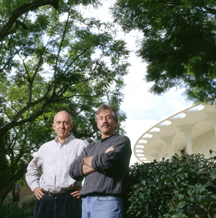
At the Caltech campus:
L: Pietro Perona, Director, Center for Neuromorphic Systems Engineering
R: Stephen Nowlin, Director, Alyce de Roulet Williamson Gallery
Photo credit: Steven A. Heller
> Download 300dpi "portrait" image
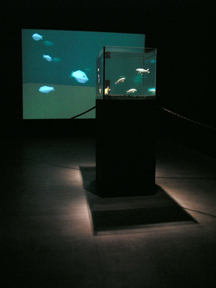
Ken Goldberg, Pietro Perona, John Bender, Ilan Lobel, Karl Chen: "Infiltrate"
Image credit: Steven A. Heller
> Download 300dpi "Infiltrate" image
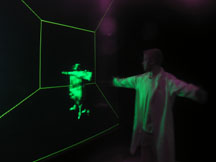
Malcolm MacIver, Simon Penny: "Body Electric"
Image credit: Steven A. Heller
> Download 300dpi "Body Electric" image
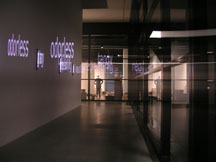
Jessica Bronson: "perpetual perceptual (about a rose)"
Image credit: Steven A. Heller
> Download 300dpi "perpetual perceptual" image
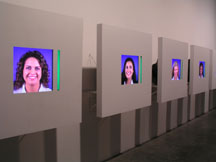
Christian Möller: "Cheese"
Image credit: Steven A. Heller
> Download 300dpi "Cheese" image
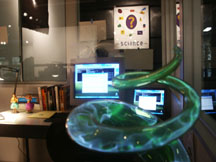
Martin Kersels, Peter Schröder: "Sciance"
Image credit: Stephen Nowlin
> Download 300dpi "Sciance" image
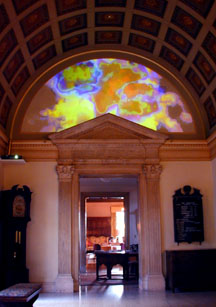
Jennifer Steinkamp: "Einstein's Dilemma"
Image credit: Jennifer Steinkamp
> Download 300dpi "Einstein's Dilemma" image
